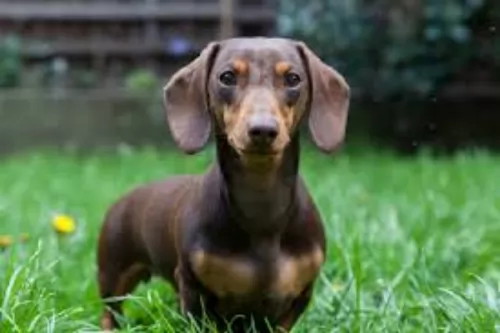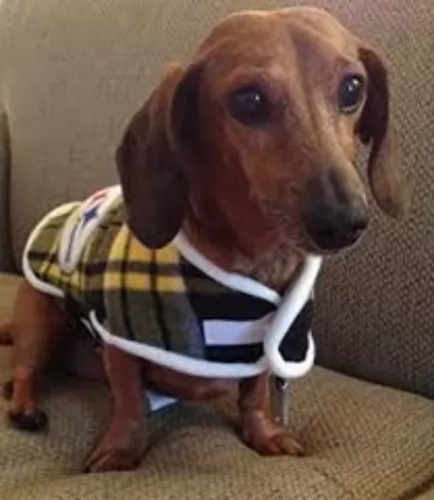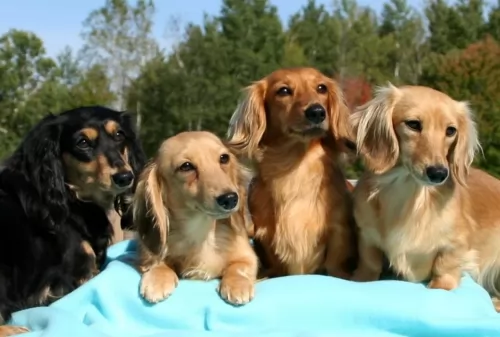 Petzlover
Petzlover American Foxhound is originated from United States but Miniature Dachshund is originated from Germany. American Foxhound may grow 46 cm / 19 inches higher than Miniature Dachshund. American Foxhound may weigh 27 kg / 60 pounds more than Miniature Dachshund. American Foxhound may live 5 years less than Miniature Dachshund. American Foxhound may have more litter size than Miniature Dachshund. Both American Foxhound and Miniature Dachshund requires Low Maintenance.
American Foxhound is originated from United States but Miniature Dachshund is originated from Germany. American Foxhound may grow 46 cm / 19 inches higher than Miniature Dachshund. American Foxhound may weigh 27 kg / 60 pounds more than Miniature Dachshund. American Foxhound may live 5 years less than Miniature Dachshund. American Foxhound may have more litter size than Miniature Dachshund. Both American Foxhound and Miniature Dachshund requires Low Maintenance.
 As a cousin of the English Foxhound, the American Foxhound is a scent hound and bred for hunting. Robert Brooke brought the first hunting dogs to the colonies in 1650. These dogs were the starting point for several American hound breeds including the American Foxhound.
As a cousin of the English Foxhound, the American Foxhound is a scent hound and bred for hunting. Robert Brooke brought the first hunting dogs to the colonies in 1650. These dogs were the starting point for several American hound breeds including the American Foxhound.
For almost 300 years the Brooke family owned and bred dogs from this bloodline.
At the same time that Brooke was hunting with and breeding his hounds, George Washington was given French Foxhounds. These were crossed with the Brooke’s dogs to create the American Foxhound. This breed is said to have been originally bred in Virginia and Maryland.
They are the state dog of Virginia. After Red Foxes were imported or migrated, Irish Foxhounds were brought to American and added into the line, increasing the stamina and speed that today’s dog’s still display.
The American Foxhound was recognized by the American Kennel Club in 1886. Today’s American Foxhound presents in many different lines but are all considered the same breed even though some ay look very different. These strains include the Trigg, Walker, Penn-Marydel, Goodman, July and Calhoun.
 The Dachshund breed is ancient and was developed in Germany sometime around the 16th century.
The Dachshund breed is ancient and was developed in Germany sometime around the 16th century.
It was in 1870 that Dachshunds first came to the United States to be used for hunting. During the 19th century, German hunters wanted smaller dachshunds.
The Dachshund was crossed with toy terriers. The coat comes in three coats – smooth-, long-haired and wire-haired. There is just one size of Miniature Dachshund in the UK and the United States.
 Given the variety of bloodlines and strains mentioned above, there can be many differences in the American Foxhounds. Because of this most American Foxhounds bred to show are Walkers as they most closely fit the AKC Breed Standard.
Given the variety of bloodlines and strains mentioned above, there can be many differences in the American Foxhounds. Because of this most American Foxhounds bred to show are Walkers as they most closely fit the AKC Breed Standard.
In general, the American Foxhound has long, straight legs and is taller than the English Foxhound. They have a narrow chest and domed skull with a long muzzle.
They have low, wide set eyes that should be dark – brown or hazel, never blue. They have feet like a fox and laid-back shoulders with a curved tail. Athletic and muscled, the American Foxhound is bred to run. They are one of the rarest breeds in the United States.
 Coming in a range of colors such as red, black, black and tan, cream, chocolate etc, the coat of the Miniature Dachshund can be long or short. Both male and females stand at between 13 – 18cm and weigh between 3 and 5kg.
Coming in a range of colors such as red, black, black and tan, cream, chocolate etc, the coat of the Miniature Dachshund can be long or short. Both male and females stand at between 13 – 18cm and weigh between 3 and 5kg.
These dogs are characterized by the long back and very short legs with floppy ears and a long tail. The face is always bright and alert.
The Miniature Dachshund is a small dog and can happily adapt to life in the city as well as in the countryside. This is because with their exercise needs, they don’t require a huge garden but can in fact, exercise indoors.
They’ve always been bred to hunt and are independent and feisty. They’re also intelligent and will do well with training and socialization.
They are also devoted to their families and are known to bark when strangers come near their family. They’ve got a lot of energy and just love being involved with games or going on a walk. Consider him when going on a walk though as his little legs have to take many more steps as compared to your one step.
They can be stubborn, but are friendly, lovable little pets, they aren’t suited for homes with toddlers unless the children have been taught to be exceedingly gentle and kind with animals, especially small, fragile ones like this. They can so easily get hurt.
 With a reputation as a docile, sweet dog, the American Foxhound is great with kids and animals. They are gentle and often very shy with strangers. They are strong willed and stubborn especially when training them, so they are not a good first dog. They need an owner who has handled dogs before and knows how to be the pack leader without being angry or mean.
With a reputation as a docile, sweet dog, the American Foxhound is great with kids and animals. They are gentle and often very shy with strangers. They are strong willed and stubborn especially when training them, so they are not a good first dog. They need an owner who has handled dogs before and knows how to be the pack leader without being angry or mean.
The American Foxhound is a scent hound and once he is on the scent it is close to impossible to distract him from it. They have a tendency to ignore commands when they are in this state. A strong owner/leader is needed for this reason. Don’t let him off leash in an unfenced area.
 The Miniature Dachshund has lots of qualities which make him such a splendid pet. He is intelligent, brave, bold and loyal with his human family.
The Miniature Dachshund has lots of qualities which make him such a splendid pet. He is intelligent, brave, bold and loyal with his human family.
He is fun-loving and energetic and thrives on lots of games and walks. He is versatile in nature and also loves to take things easy indoors with his family.
These little dogs form strong bonds with their family and don’t like to be left on their own. When you have one of these as a pet you’re allowing a whole lot of joy into your home.
 The American Foxhound, like most hunting dogs does not carry a lot of genetic disorders. But they can easily become overweight and this can cause major problems. Dysplasia of any type had been mostly unknown in this breed, but due to obesity it is cropping up on occasion. Breeders have not, and do not usually screed for any genetic diseases.
The American Foxhound, like most hunting dogs does not carry a lot of genetic disorders. But they can easily become overweight and this can cause major problems. Dysplasia of any type had been mostly unknown in this breed, but due to obesity it is cropping up on occasion. Breeders have not, and do not usually screed for any genetic diseases.
The most devastating health issue the American Foxhound faces is thrombocytopathy. We will go into more detail on this in the Care for Pet section. This is a disease of the blood system, namely the platelets.
 Be very careful with the Miniature Dachshund because of their long backs. You don't want to be allowing him to be jumping off chairs etc as their backs are prone to injury. To solve the problem you can buy special stairs and ramps for small dogs.
Be very careful with the Miniature Dachshund because of their long backs. You don't want to be allowing him to be jumping off chairs etc as their backs are prone to injury. To solve the problem you can buy special stairs and ramps for small dogs.
They can live to be between 12 and 14 years of age when looked after well.
A disease that is fairly common in the Miniature Dachshund is Intervertebral Disc Disease, a condition where the cushioning discs between the vertebrae of the spinal column bulge or burst into the spinal cord space, pressing on the nerves and causing nerve damage and worse, paralysis.
 Whether feeding a pup, or an adult American Foxhound, you need to be sure the food is high quality and that you don’t overfeed. The Foxhound is happy to eat as much as you give him. They like to eat. Make sure you measure and don’t free feed. Control what they are eating.
Whether feeding a pup, or an adult American Foxhound, you need to be sure the food is high quality and that you don’t overfeed. The Foxhound is happy to eat as much as you give him. They like to eat. Make sure you measure and don’t free feed. Control what they are eating.
For a puppy feed twice, a day – 2 to 3 cups of high quality puppy food. When he becomes an adult feed him once a day with 2 cups of adult food.
As mentioned previously, the American English Foxhound, like most of the hound breeds is a very healthy dog. They do not have many genetic health issues. They do have a risk for thrombocytopathy. This risk is slight, but all owners of American English Foxhounds should be aware of it.
This disease is a circulatory system disease with poorly or non-functioning platelets. Platelets are designed to assist in the control of bleeding and without functioning ones the dog can bleed excessively from just a minor cut or bleed internally from a minor injury. The disease can be treated but you have to notice it first. Depending on how severe the disease is, the treatment will vary. Some dogs will have to be given platelets.
This is a high energy breed that is very active and needs a lot of exercise. They are not good for the first-time owner as they are stubborn and hard to train. They need room to run and get frustrated and out of sorts if they don’t have it. They can live in the suburbs but only with a large fenced yard, an even larger dog park and regular walks. This dog needs a lot of exercise. The simplest thing to do is take him hunting.
 Dachshunds can put on weight quickly and you want to avoid this at all costs as extra weight can put strain on the back.
Dachshunds can put on weight quickly and you want to avoid this at all costs as extra weight can put strain on the back.
If you feed your Mini Dachshund commercially manufactured dog food, choose the best quality ones, high in vitamins and minerals and avoid some of the cheaper ones that use unwholesome fillers, colorants, sugar and lots of salt, all of which can be toxic for your pet.
Of course home-made food is always best, but not any foods either. It is best with any dog to keep their foods simple and consistent so as to avoid stomach problems. Chopped up boiled chicken, brown rice or pasta and some cooked vegetables such as potatoes carrots and spinach will do wonders for him. Make sure that there is a constant supply of fresh, cool water for him.
A good brush of the coat twice a week will do fine for your Miniature Dachshund. Remember to check him over for fleas and ticks when you brush him and to feel for any unusual lumps. Keep the nails trimmed.
Check both eyes and ears for infection. There are ways to keep the inside of long eared dog breeds clean and dry, but if you’re unsure there are always professional groomers who will do the job for you, and clean their teeth at the same time. You can brush your dogs teeth 2 or 3 times a week to avoid plaque build up, gum infection and tooth loss.